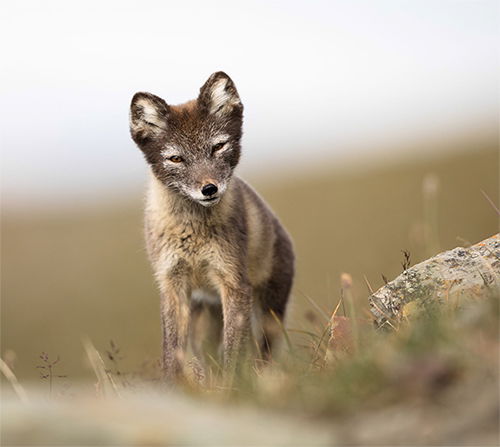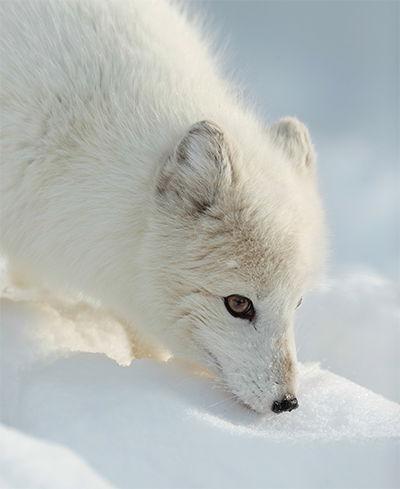How the Arctic Fox Got Its Winter Wardrobe
When winter arrives, this fox takes off his thin summer coat and puts on a luxurious new wardrobe just for the occasion.
Imagine a dark and frozen world where all who enter are surrounded by deadly threats—hurricane-force winds, months of darkness, snow blindness, and temperatures so cold that water thrown from a cup freezes before it hits the ground. Yet in this forbidding environment, Jesus has endowed one creature with all the equipment necessary not only to survive but, incredibly, to thrive.
He goes by many names, including snow fox, polar fox, and Arctic fox. Scientists call him Vulpes lagopus (hare-footed fox) because he grows hair on the underside of his feet—similar to the rabbit-like hares that share this frozen world with him.
I personally got to know two of these amazing canids, named Yana and Yukon, while working as a volunteer at a small wolf center in upstate New York. The nature center’s mission was to educate the public about the wonders of native wolves and foxes. As part of my training, I had the privilege of bonding with these two foxes so they’d be comfortable during my talks with visitors. They taught me a lot as I watched them interact with each other, play with my boot laces, and drastically transform through the seasons.
What a transformation, as their trim, blue-gray bodies changed to snow-white puffballs by winter! Visiting their pen on frigid winter days, I marveled how they slept directly on the frozen surface of their pen’s artificial spring, just as snuggly as if it were a fluffy, warm comforter in my heated cabin. Our God of provision clearly has endowed these special animals to flourish in the stark but beautiful Arctic.
The Arctic Challenge
Our triune Creator has filled the planet with diversity. It is no different with foxes, from the fennec fox of the Sahara to the red fox of the high mountains of the Sierra Nevada. Arctic foxes are circumpolar, meaning they inhabit the cold regions surrounding the north pole: Greenland, Scandinavia, Siberia, Alaska, and Canada.
The major habitat of the region is tundra—a windswept, treeless plain where the soil beneath your feet can be frozen 1,000 feet down. Winter temperatures easily plummet to –50°F (–46°C). Winds can be 60 mph or greater, causing whiteout conditions that impede all visibility and lower the windchill to deadly extremes.
Making matters more challenging, light is absent for several months in the winter. When you hang out with Arctic foxes, at first glance it doesn’t seem like they would do well in such an environment. For example, they are antisocial and don’t believe in group huddles to keep warm. They are also small, about the size of a large house cat, and that is a problem. The smaller the animal, the more body surface contacting the cold. That puts them in danger of heat loss, hypothermia, and death. Yet despite these challenges, our snow foxes prosper. There must be more to them than meets the eye!
Transition from Summer to Winter
During the summer, I would visit Yana and Yukon and marvel at how skinny they were. Only 6% of their body weight was fat. They spent a lot of time swimming and cooling off in their pool. As summer transitioned to fall, our Creator’s genius became evident as his genetic programming in my fox friends responded to shortening days, and their bodies gradually transformed before my eyes.

Summer Coat: In summer, the Arctic fox’s coat is much thinner and darker, and its body is leaner. Both coat and body undergo marvelous changes as winter approaches.
Thin fur grew thicker and covered not only their legs but the underside of their paws, just as their “hare foot” Latin name describes. Hair color transitioned from blue-gray to white. Fat accumulated from a measly 6% to 30% of their weight, and by January they looked like marshmallows with toothpick legs.

Finding Food Under the Snow: Arctic foxes use their excellent sense of smell to detect prey burrowing underneath the snow.
In winter, Arctic foxes’ fur increases 140% in multiple layers on their bodies, and extra fur grows on their feet, providing excellent insulation and greatly compensating for their small size. The furry tail insulates them further because it acts as both mattress and facial scarf on the coldest and windiest of nights. Little ears, set close to the body, assure minimal heat loss, while the dramatic increase in fat provides further insulation and an energy reserve when food is scarce. But wait, there’s more . . . God is not yet done providing for Yana and Yukon.
Foxes in the Freezer
In studies to determine how animals survive cold environments, scientists use a measure called the lower critical temperature. It is defined as the air temperature at which an animal must really start working hard to stay warm. They work hard by burning fat reserves and shivering. The lower their critical temperature, the more resistant mammals are to the ravages of cold.
Because of their fur and fat, mammals living around the north pole have the lowest lower critical temperatures. And Arctic foxes are champs. One study examined individual fox behavior and their vital signs, such as respiration and heart rate, by putting them in an environment where temperatures could be controlled. At –58° to –76°F, the fox went to sleep and body temperatures remained steady. At –94°F, the fox licked his feet for half an hour, slept for an hour, and shivered. At –112°F, he began to shiver in the first five minutes but his body temperature did not drop for an hour.
Just what is the lower critical temperature of our polar fox? That is up for debate. When I was hanging out with Yana and Yukon, the prevailing thoughts were that it was –40° to –70°F (–40° to –57°C). Other research suggests that it might be closer to –7°F. Think about that for a moment. Even using the most conservative numbers, as air temperatures plummet well below zero, these marshmallows don’t really have to start working at staying warm until between –7° and –40°F. That explains why Yana and Yukon looked comfortable on their ice bed when it was 10 below zero in New York.
Navigating an Arctic World
Proper navigational equipment is crucial for orienting in the frozen tundra, especially with pitch dark winters and windy whiteouts. So it is no surprise that Arctic foxes have excellent day and night vision. As with many night mammals, the Arctic fox has an amazing structure in the back of its eye (tapetum lucidum) that works like a mirror, capturing every sliver of incoming starlight or moonlight and reflecting it back through the eye’s retina, enabling it to see well in the dark. You have seen the effects of this special structure if you have ever shined a light into the dark and observed glowing red eyes glaring back at you. That eye glow is the product of your light being reflected back through the eye and out the pupil.
If you are a dog owner, you know Rover’s eyes can do the same thing. But in the daytime, the sun’s reflection off ice and snow can cause an intense glare, resulting in painful snow blindness. Yana and Yukon look like they have a constant squint in bright sun. That behavior allows them to see clearly but safely, even during the most dazzlingly brilliant days in the Arctic (and New York).
Their senses of smell and hearing are also superior. Foxes will eat almost anything. However, a lot of what they eat is either dead, living under the snow, or white as snow. This is where their superior hearing and smell are crucial. They can listen to small rodents running under the snow, track the trajectory of the sound, and dive head first to catch them. They also scavenge and stash food for future use, but they must later find it, even when it’s buried under several feet of snow. Their amazing noses help them relocate their larders and also smell meat that polar bears have killed. They’re crafty too, following polar bears and eating their leftovers after they move on. Their nose also allows them to detect nearly invisible, snow-white Arctic birds called ptarmigans.
Finally, remember those furry underpaws? Well, more is going on than superior insulation. They also provide better traction to keep them from slipping on ice.
Even with this insulation, the paws are exposed to extreme temperatures that sap a lot of heat. So these special feet are outfitted with a superbly engineered system known as countercurrent heat exchange. Arteries carrying warm blood from the heart intertwine with veins traveling from the feet and transfer heat to them. By the time cold blood reaches the heart it is warmed, so internal organs aren’t stressed by chilled blood. At the same time, the warm blood traveling to the feet is cooled, so less heat is lost to the icy landscape. The less heat the polar fox loses, the more fuel it saves.
Needs of a Cold World
What is the main reason God built this design into the Arctic fox’s genetic makeup? Seriously, ask yourself that question next time you see an adorable animal that amazes you. It’s not just so animals could survive or to prove God’s existence or his wisdom or that God is the Creator of life.
God displays his glory throughout creation (see Psalm 104, especially verses 24–31). Above all, we were created to wonder and to praise him. Speaking about the pagan, unbelieving culture of the Romans, Paul reminds us that God’s invisible qualities and divine nature are clearly seen in creation, so that we are without excuse if we do not praise him as these wonders naturally inspire us to do (Romans 1:20–21).
We also know that when Adam declared independence from God and rebelled, his sin brought a raw and icy coldness to this world. Its chill stings as we suffer and die. It makes enemies out of friends, prey out of former partners. As I think about my time with Yana and Yukon, I meditate on how far we have come since our once-perfect world where fox and hare lay down together. But we see how God still provides for their needs.
Our needs go deeper than combating the cold or avoiding death. God in his infinite love, through the death of his only Son, can transform our ice-cold, stony hearts into living flesh (Ezekiel 36:26). As much as he cares for Yukon and Yana, how much more he cares about those made in his image! As we repent of our sins and trust in Jesus Christ, his Spirit transforms us from spiritual darkness into people who can see God’s glorious light.
Those who experience God’s grace and love are equipped with new spiritual powers that far exceed anything he gave other creatures, including our ability to find spiritual warmth, rest, and peace no matter what our hostile, frozen world hurls against us. That’s a gift that exceeds all others!
Designed from Head to Toe

- Ears & Nose: Small ears close to the body and a short muzzle minimize surface area and reduce heat loss.
- Paws: Hair on the bottom of the feet provides insulation from walking on the ice and snow.
- Body: A 140% increase in fur and a fivefold increase in fat (from 6% to 30%) retain extra warmth in winter.
- Tail: A fluffy tail makes an insulated pillow and a luxurious neck scarf.
Answers Magazine
January–February 2018
When winter arrives, this fox puts on his new wardrobe just for the ocassion.
Browse Issue SubscribeRecommended Resources

Answers in Genesis is an apologetics ministry, dedicated to helping Christians defend their faith and proclaim the good news of Jesus Christ.
- Customer Service 800.778.3390
- © 2024 Answers in Genesis






